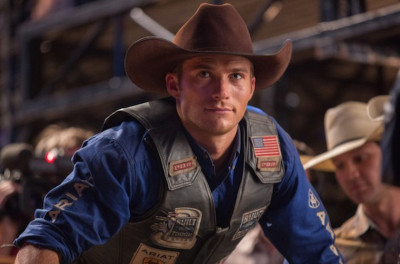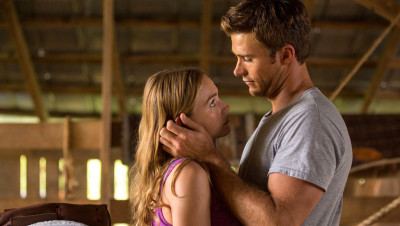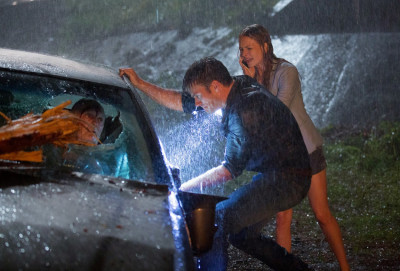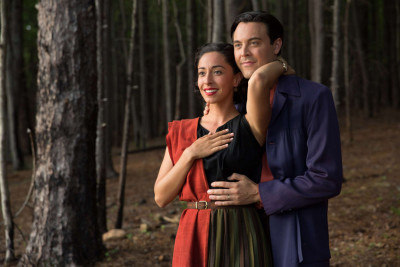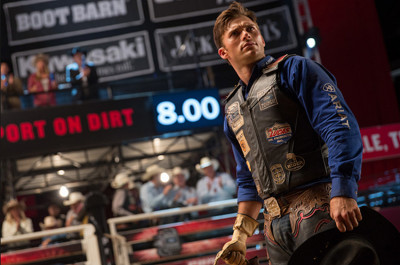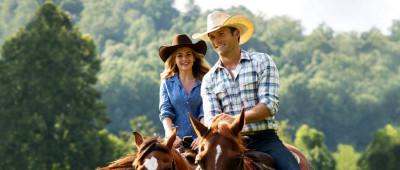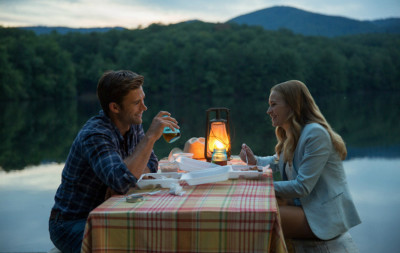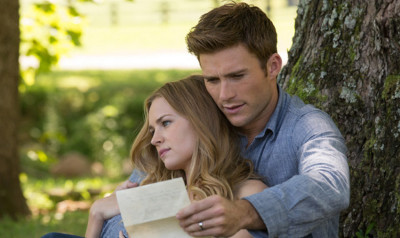Let’s just get it out there now so there’s no mistaking. Nicholas Sparks is Nicholas Sparks is Nicholas Sparks. You know what you’re going to get (for the most part) when you pick up a Sparks novel or sit down to watch a Sparks adaptation on the big screen. You know there will be beautiful scenery with lots of sun, lots of greenery, lots of rain (literally and metaphorically), lots of tears and lots of very fine looking people. You also know that in probably 75% of the stories, generations will collide with cosmic beauty and life lessons will be imparted. And finally, you know there is always a core theme of love and that boxes of tissues are required viewing accouterments over popcorn. But what you don’t know is that in films like THE LONGEST RIDE, those life lessons, generational ties and love, extend beyond the story and the film and into the very individuals who bring this story to life. And that’s what makes THE LONGEST RIDE one of the best Sparks’ adaptations ever.
Luke Collins is a champion bull rider. (All you “Cowtown Rodeo” fans start rejoicing now as the bull riding footage throughout is explosive!) Wanting to reach the pinnacle of success and surpass the legend of his father in order to earn enough winnings and endorsements to keep the family ranch, Luke is the salt of the earth. . .and mighty fine to look at, too. We first meet him when he is thrown from the most vicious bull on the rodeo circuit, Rango, and quickly jump ahead in time to him trying to re-ignite his career. His journey back from the life threatening accident plays out during the course of the film.
And yes, the fact that it is Scott Eastwood who looks like the spittin’ image of his own father Clint in his “Rawhide” days, not only with his look, but his mannerisms, sly smile, and even vocal inflections with certain phrases playing Luke Collins, only serves the character and the film on multiple levels. Then put Eastwood on a bull or a horse and you’d swear you’re in a time machine looking at Clint, putting the visual imagery hand-in-hand with the parallel generational storylines at play in THE LONGEST RIDE.
Now while you’re doing double takes at the young Mr. Eastwood, we’re also meeting art history academic from local Wake Forest College, Sophia Danko. One of those girls with her head in a book and career path meticulously mapped out, Sophia is reluctantly dragged by her sorority sisters to the local rodeo to check out “the hottest guys around” – the cowboys. Needless to say, a flip of his Stetson onto the ground in front of Sophia is all it takes for her head to spin Luke’s way. And of course, he does more than a double take when he sees her.
As old-fashioned romance ensues – Luke brings flowers to Sophia on their first date, he does the asking instead of her, he takes her on an afternoon turned moonlit evening lakeside picnic – but not without some trouble. Given that Sophia is leaving for New York in two months for an internship, and given their very different backgrounds (she’s a first generation Polish immigrant, he’s from a lineage of ranchers), she doesn’t want to “get involved” with the handsome wrangler; especially since he won’t give up his 8 second dream of bull riding and move to New York should they “hit it off” and she won’t give up her dreams in the art world.
But as luck, and Nicholas Sparks, would have it, as the skies open to a raging thunderstorm and their date comes to an end, ever the gentleman hero, on their way back to Sophia’s sorority house Luke sees a car that has careened off the road and is on fire. Rushing to aid any victims, they find one, an elderly man who Luke pulls from the car while Sophia rescues “a box” the man whispers he needs.
Sophia determines to stay at the hospital with the man while Luke takes off. The man they saved is Ira Levinson. The box they saved contains a lifetime of letters from Ira to the love of his life, Ruth, starting with their meeting in pre-war 1940 North Carolina. It is through these letters and a precious friendship that develops between Ira and Sophia that we see the love and history of Ira and Ruth repeat itself through Luke and Sophia. With each letter we are visually transported back in time and watch the love, and heartaches, of Ira and Ruth unfold. Sacrifices made, acceptance of certain elements of life, but en eternal love, we see Ira embrace Ruth’s passion for art and in lieu of children, works of art become their children. And it’s Ira’s sage counsel that helps guide Sophia; not to mention Luke suffering another life-threatening throw from a bull.
But is the love of Sophia and Luke strong enough to bring them together the way that of Ira and Ruth?
When it comes to performances, all are rock solid, starting with Scott Eastwood. Going beyond his DNA connection and those crows feet squintless eye creases to the sly smile or scowl to certain phrases and vocal inflection, and repeatedly telling yourself this is Scott Eastwood, not Clint, Scott Eastwood solidifies himself as one of Hollywood’s new leading men. And after seeing him make his mark in that capacity with last fall’s indie gem, “The Perfect Wave” and with the diversity and number of films on his upcoming plate, Eastwood more than proves that he is the real deal. With a casual ease, he commands the screen with few words. He sits a horse or a bull with easy confidence. His charismatic masculinity infused with a gentility melts the heart while his blue eyes will make every woman go weak in the knees. But it’s that quiet command that steers the character and by its virtue, the story and film as a whole.
Brit Robertson is more than a match for Eastwood, but beyond Eastwood, she delights when playing opposite Alan Alda. Bringing a determined freshness to Sophia, she lights up the screen and is particularly effective when placed in freeing exterior settings. And when with Alda, the chemistry is tender, poignant and very familial.
And what about Alan Alda as the 79-year old plays a 91 year old widower? In a word. Perfection. Alda grounds the film with heart and wisdom. He slows Ira’s speech and is more deliberate in enunciation (than he normally is!), speaking tonally lower, resulting in that “pay attention” feeling we have all experienced when a grandparent or sage mentor is imparting life lessons to us. And here’s where you need the boxes of tissues. Lots of them. Kleenex can thank Alan Alda and Nicholas Sparks when stock prices rise.
Joyous are the performances of Jack Huston and Oona Chaplin. Yes. From “those” Hustons and “that” Chaplin. Jack, grandson of John and great-grandson of Walter, and Oona, granddaughter of Charlie and Oona (for whom she was named), are luminous as the 1940’s Ira and Ruth. Not just lensed beautifully by cinematographer David Tattersall and costumed in period clothing, Huston and Chaplin are luminous. They embody these roles with the ease and comfort of “knowing” the people they are playing, knowing the era in which they are transported. They are radiant with emotion, particularly Huston who manages a wide-eyed glow that comes from the heart. Watching Huston and Chaplin feels as if time has stood still.
Not to be overlooked is a nice turn by Lolita Davidovich who also provides parental moments of thought and reflection as Luke’s mother Kate.
Notable is that despite his best efforts to sneak onto some bulls, Scott Eastwood’s thunder was pulled out from under and professional PBR (Professional Bull Rider Association) riders were brought in as his stunt riding doubles, in particular Brant Atwood who was Eastwood’s primary double and who rode “Rango.” With the PBR serving as technical advisors on the film, PBR fans should easily pick out champions Kody Lostroh and Billy Robinson who play themselves in the film.
Directed by George Tillman, Jr. from script by Craig Bolotin (who penned the hilarious “Straight Talk” for Dolly Parton some 23 years ago) adapted from the Nicholas Sparks novel of the same name, THE LONGEST RIDE is further proof that producers Wyck Godfrey and Marty Bowen are the best producers for Sparks adaptations as they allow for the script and direction of the project to expand beyond the printed pages of the book. What we see unfold is essentially three complete stories from three different worlds that seamlessly meld – the 1940’s and the story of Ruth and Ira, the 21st century and the story of Luke and Sophia, and then the bull riding and rodeo world with the art world making its stand with bull riding and art serving as the connective metaphoric tissue for love and relationships. With Tillman at the directorial helm, time is both distinct and timeless as past meets present while standing on its own and vice versa. The parallels between the generational love stories is poignant perfection fueled by passion and truth, creating tonal energies that resonate on every level. Key is that nothing feels forced or contrived. The flow of the parallel love story does just that – flows with a natural languidity.
David Tattersall’s cinematography is lush with natural lighting. Nuanced changes in framing and light hues fuel the temporal changes with a slightly golden patina caressing the vintage love story. Bull riding scenes are phenomenal not only with camera work, but with editing. Challenging for both Tillman and Tattersall, however, was lensing the bulls and particularly Rango, on whom they had five cameras trained in the hope of capturing the all important 8-second ride. Having been to PBR and other rodeo and bull riding events myself, the lensing and editing of the bull riding sequences are as intense as if being there in person. Significant in the editing of THE LONGEST RIDE is not only for its part in the telling of Luke’s emotional journey, but for the metaphor of love and “the toughest sport on dirt” juxtapositioned with the beauty of art and the parallels in the lives of Luke and Sophia and Ira and Ruth.
Applause goes to production designer Mark Garner who, together with the location team, found the beautiful Victorian stylings of Ruth and Ira’s world in both Wilmington, North Carolina and Wallace, North Carolina. Both towns are so authentic to the era of Ira’s youth and that of Ruth and Ira as a growing married couple, that the effect is transformative and immersive for the audience. It’s as if time – and their love – stood still. Wonderful metaphoric storytelling tool.
As Sandy Powell did in “Cinderella” to capture the beautiful blue eyes of Richard Madden, so does costumer Mary Claire Hannan with clothing for Eastwood’s Luke as she dresses him a blue shirt, the same style blue shirt, in every scene. It not only brings out his eyes, but makes him readily identifiable. Also notable is the attention to detail with the leatherwork of not only Eastwood’s attire but the other bullriders and cowboys, from chaps to belts along with those impressive silver champion belt buckles riders wear. As in real life, cowboys, riders and competitors in rodeos and the PBR circuit (Professional Bull Riders) have all custom made and break them in over their competitive lifetimes. Beautiful hand tooling work. Standout is Hannan’s work with Ruth’s clothing. In addition to Ruth being an art lover and artist, she was very fashion conscious and fashion forward. Hannan embraced the era and celebrated fashion and personality with color blocking, soutache braiding, buttons and patterned embroidery of the day.
Completing the ride is Mark Isham’s scoring. Emotional and evocative and never more perfect than in the 1940s ocean vacation sequences. A beauteous result that truly embraces “love”.
THE LONGEST RIDE is truly one of Sparks’ most unforgettable rides. There is more substance to the parallel story lines constructed on film that are more satisfying and tonally superlative to that of “The Notebook”. Tillman completely captured and embraced 1940’s mores – and those of the South and immigrants in the South – visually and through direct declaratory conversational dialogue while finding that tonal sweet spot between past and present. There is a real beauty to the “fish out of water” aspects of the individual characters Ruth and Ira/Sophia and Luke and how that very thing is what shapes lives and loves.
THE LONGEST RIDE is one ride I don’t want to see end.
Directed by George Tillman, Jr.
Written by Craig Bolotin adapted from the novel by Nicholas Sparks
Cast: Scott Eastwood, Brit Robertson, Jack Huston, Oona Chaplin, Lolita Davidovich and Alan Alda

